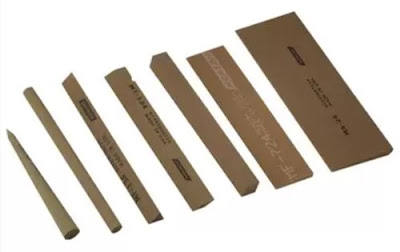Also called lapping, sharpening, or whetstones, stones are used for polishing and honing, i.e. to produce a smooth finish, while files are generally considered to be tools for removing material. There are many different types and grades of stones to choose from, especially when working metal, but some are designed to be used for other materials such as glass.
For this article, grinding wheels, although technically stones, are grouped with files as they are primarily used for metal removal.
Natural stones are frequently named after their source
location, such as Arkansas stones. Most Americans who’ve use a sharpening stone
have probably used an Arkansas stone; they’re mined primarily in the Ouachita
Mountains of Arkansas, but smaller outcrops can also be found in western Texas,
Oklahoma, Japan, Syria, Lebanon, and Israel. Arkansas stones are a form of
Novaculite, a Latin word meaning "razor stone," which gives you an idea how old the use of stones for sharpening is. Arkansas
stones are something of an industry standard, as they are very consistent in
hardness and contain few impurities that affect their use.
Artificial stones are a combination of some type of bonding
material (such as epoxy) and one or more abrasive grains (such as aluminum
oxide, zirconium oxide, or silicone carbide). The material chosen and the
specific size of the grains will determine both its cutting speed and finish
quality.
For the casual user, the main difference between the two
types of stone are price, as artificial stones are generally less expensive than similarly-sized natural stones. However, there are some very
cheap natural stones available that are often not worth even their very low
price, and these low-end stones will usually break easily, cut poorly, and produce
a poor finish.
- It causes stone particles to “float” on top of the surface, forming a slurry that can improve surface finish;
- The fluid also limits particles from being caught in the grain of the stone which can reduce the cutting ability or cause scratches;
- Wetting a stone (not to be confused with a whetstone) can simplify cleanup.
 |
| Please don't ever do this. |
As with any tool, proper care is essential for longevity. Unlike many other tools, stones are a consumable item. I’m sure most people have seen an old sharpening stone that has become almost bowl-shaped over time. When a stone is no longer capable of doing its intended job properly and easily, don’t hesitate to demote it and purchase a replacement.




No comments:
Post a Comment